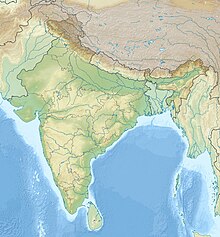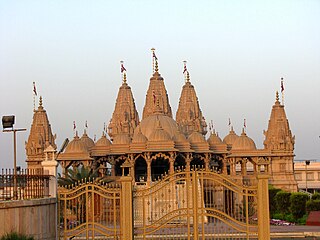
Bharuch, formerly known as Bharutkutccha, is a city at the mouth of the river Narmada in Gujarat in western India. Bharuch is the administrative headquarters of Bharuch District.

Rock-cut architecture is the creation of structures, buildings, and sculptures by excavating solid rock where it naturally occurs. Intensely laborious when using ancient tools and methods, rock-cut architecture was presumably combined with quarrying the rock for use elsewhere. In India and China, the terms cave and cavern are often applied to this form of man-made architecture, but caves and caverns that began in natural form are not considered to be rock-cut architecture even if extensively modified. Although rock-cut structures differ from traditionally built structures in many ways, many rock-cut structures are made to replicate the facade or interior of traditional architectural forms. Interiors were usually carved out by starting at the roof of the planned space and then working downward. This technique prevents stones falling on workers below. The three main uses of rock-cut architecture were temples, tombs, and dwellings.
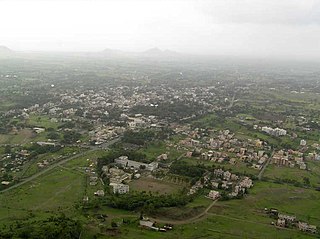
Junnar is a city in the Pune district of the Indian state of Maharashtra. The city has history dating back to the first millennium. The nearby fort of Shivneri was the birthplace of Maratha king Shivaji, the founder of the Maratha Empire. Junnar was declared the first tourism taluka in Pune district by the government of Maharashtra on 9 January 2018.
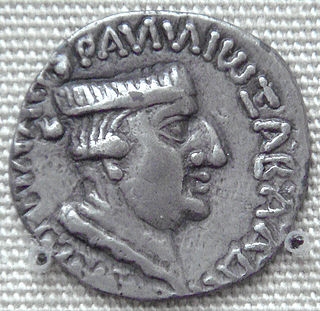
Nahapana, was an important ruler of the Western Kshatrapas, descendant of the Indo-Scythians, in northwestern India, who ruled during the 1st or 2nd century CE. According to one of his coins, he was the son of Bhumaka.

Taranga is a Jain pilgrimage center near Kheralu in Mehsana district, Gujarat, India, with two compounds of Jain temples that are important examples of the Māru-Gurjara style of architecture. The Ajitnatha temple, was constructed in 1161 by the Solanki king Kumarapala, under the advice of his teacher, Acharya Hemachandra. Both the main sects of Jainism are represented, with adjoining walled compounds: the Śvetāmbara compound consists of 14 temples in all, and there are also five Digambara-affiliated temples at Taranga hill.

Indian rock-cut architecture is more various and found in greater abundance in that country than any other form of rock-cut architecture around the world. Rock-cut architecture is the practice of creating a structure by carving it out of solid natural rock. Rock that is not part of the structure is removed until the only rock left makes up the architectural elements of the excavated interior. Indian rock-cut architecture is mostly religious in nature.

Bhaja Caves are a group of 22 rock-cut caves dating back to the 2nd century BC located off the Mumbai - Pune expressway near the city of Pune, India. The caves are 400 feet above the village of Bhaja, on an important ancient trade route running from the Arabian Sea eastward into the Deccan Plateau. The inscriptions and the cave temple are protected as a Monument of National Importance, by the Archaeological Survey of India per Notification No. 2407-A. It belongs to the Early Buddhist schools in Maharashtra. The caves have a number of stupas, one of their significant features. The most prominent excavation is its chaitya, a good example of the early development of this form from wooden architecture, with a vaulted horseshoe ceiling. Its vihara has a pillared verandah in front and is adorned with unique reliefs. These caves are notable for their indications of the awareness of wooden architecture. The carvings prove that tabla – a percussion instrument – was used in India for at least 2300 years, disproving the centuries-held belief that the tabla was introduced to India by outsiders or from Turko-Arab. The carving shows a woman playing tabla and another woman, performing dance.

South Gujarat, also known as Dakshin Gujarat, is a region in the Indian state of Gujarat. The region has a wetter climate than other regions of Gujarat. The western part is almost coastal and is known as Kantha Vistar, and the eastern part is also known as Dungar Vistar, which ranges from 100 to 1000 metres, with the highest peak at Saputara in the Dang district.

Junagadh Cave Groups are located in Junagadh district of the Indian state of Gujarat. These caves group includes Uparkot Caves, Khapra Kodiya Caves and Baba Pyare Caves. Three separate sites of rooms carved out of stone to be used as monks' quarters. These caves were carved starting from Emperor Ashoka's period up to 1st–4th century AD.
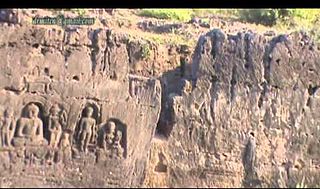
The Dhank Caves are located near Dhank village near Upleta, Rajkot district, Gujarat, India. They were chiseled out of a calcareous sandstone outcropping during the regime of the Western Satraps. The caves are influenced by Buddhist and Jain cultures. The Jain cave includes figures of Adinath, Shantinath and Pārśva. These are considered to be the earliest Jain sculptures in Kathiawad.

The Talaja Caves are located in Bhavnagar district of the Indian state of Gujarat at Talaja. The rock cuts are carved out into deserted conical rocks. The rock cut group include 30 caves among which about 15 are water tanks. The cave has unique architecture known as Ebhal Mandapa. The halls are plain. "On the facade there are chaitya windows with a broad bank below them." The chaitya and cells were carved during a time of Buddhist influence in the 2nd century BC.

There are two sets of Buddhist caves in two different places taking the name of Shana caves.

Khambhalida Caves, are three Buddhist caves located in Jetpur in Gujarat, India.
The Siyot Caves, sometimes referred to as the Kateshwar Buddhist Caves, are five rock-cut caves located near Siyot village in the Lakpat Taluka of Kutch district, Gujarat, India. The caves are believed to belong to the first century AD.

Tourism in Marathwada refers to tourism in the Marathwada region of Maharashtra state in India. Aurangabad is a regional headquarters in Marathwada, and the tourism capital of Maharashtra state. Out of the four UNESCO World Heritage Sites in Maharashtra, two are in the Marathwada region. There are also 110 monuments in Marathwada which are protected by Government of Maharashtra and recognized by Archaeological Survey of India.

The Lomas Rishi Cave, also called the Grotto of Lomas Rishi, is one of the man-made Barabar Caves in the Barabar and Nagarjuni hills of Jehanabad district in the Indian state of Bihar. This rock-cut cave was carved out as a sanctuary. It was built during the Ashokan period of the Maurya Empire in the 3rd century BC, as part of the sacred architecture of the Ajivikas, an ancient religious and philosophical group of India that competed with Jainism and became extinct over time. Ājīvikas were atheists and rejected ritualism of the Puranic karma Kāṇḍa as well as Buddhist ideas. They were ascetic communities and meditated in the Barabar caves. Still, the Lomas Rishi cave lacks an explicit epigraphical dedication to the Ajivikas, contrary to most other Barabar Caves, and may rather have been built by Ashoka for the Buddhists.

Uparkot caves, also Uperkot caves, are ancient man-made caverns. The caves are a part of the Junagadh Buddhist Cave Groups situated in the eastern part of Junagadh of the Indian state of Gujarat.

The Buddhist caves in India form an important part of Indian rock-cut architecture, and are among the most prolific examples of rock-cut architecture around the world. There are more than 1,500 known rock cut structures in India, out of which about 1000 were made by Buddhists, 300 by Hindus, and 200 by Jains. Many of these structures contain works of art of global importance, and many later caves from the Mahayana period are adorned with exquisite stone carvings. These ancient and medieval structures represent significant achievements of structural engineering and craftsmanship.

The Khapra Kodiya Caves are part of the Junagadh Buddhist Cave Group. They are the oldest of the caves in the group. The caves, on the basis of scribbles and short cursive letters on the wall, are dated to 3rd-4th century BCE during the Emperor Ashoka's rule and are the plainest of all the caves in the groups. These caves are also known as Khangar Mahal. They were carved in rock during the reign of Emperor Ashoka and are considered the earliest monastic settlement in the area. These caves are along the edge of the ancient Sudarshan Lake and a little outside Uparkot fort, to the north.


